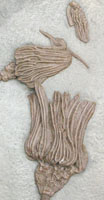Crinoids, commonly known as sea lilies, are ocean dwelling creatures that lived attached to the sea floor. They consist of three main body parts: the arms that filter food particles out of the water, the head (or calyx) that houses the internal organs and mouth parts, and the stem that attaches the crinoid to the sea floor. In spite of their plant-like appearance, crinoids are animals. They belong to a phylum of sea creatures known as Echinodermata, meaning "spiny skin." Examples of other non-extinct echinoderms include sea urchins, sand dollars, sea cucumbers, and starfish.
The original fossils replicated here (Actinocrinites gibsoni, Macrocrinus mundulus, and Halysiocrinus nodosus) were found in Montgomery County, Indiana, in the marine deposits of the Edwardsville Formation. These sediments date back approximately 345 million years to the Mississippian Age when crinoids reached their peak, carpeting the floors of shallow seas. The Mississippian Age has been dubbed "The Age of Crinoids." From the fossil record about 2,100 crinoid species are known and 800 species survive today. Modern day crinoids live at great depths in the ocean. Since echinoderms disarticulate easily when they die, pieces of fossilized crinoid stems are commonly found but complete crinoids are a rare and treasured find.
Crinoids 
Quantity in Basket: None
Code: ECH-100
Price: $182.50
Shipping Weight: 2.88 pounds
Species: Actinocrinites gibsoni (2), Macrocrinus mundulus, Halysiocrinus nodosus.
Time: Mississippian age 345 million years ago
Location: Edwardsville Formation, Indiana, USA
Dimensions: 15-1/4" x 9" x 2"